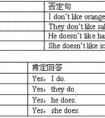用方框内所给动词的适当形式填空。prepare have show wear prefer visit return run like snow knock stop 1. Mr Li ______ rice to bread. What about you?2. He is no-九年级英语
There is something wrong with your watch, isn't there?
There will not be any trouble, will there?
19) 否定前缀不能视为否定词,其反意疑问句仍用否定形式。
It is impossible, isn't it?
He is not unkind to his classmates, is he?
有些动词如:cost hurt hit put 等,它们的过去时与原型相同,在肯定句中一定要先弄清楚它们是什么时态.
1.祈使句。祈使句后一般加上will you或won't you构成反意疑问句,用will you 多表
示“请求”,用won't you 多表示提醒对方注意。例如:
Look at the blackboard, will you/ won't you?看黑板,好吗?
Let 引导的祈使句有两种情况:
1) Let's...后的反意疑问句用shall we或shan't we。例如:
Let's go home, shall we/ shan't we? 回家吧,好吗?
还可以用may I来表示征求对方的同意或许可。
2) Let us/me...后的反意疑问句用will you或won't you。例如:
Let me have a try, will you/won't you? 让我试一试,行吗?
2. 感叹句。感叹句后加反意疑问句时,其反意疑问句需用be的一般现在时态的否定形式。 例如:
What fine weather, isn't it? 多好的天气啊,是吧?
3. 当陈述部分谓语动词是need, dare, used to,且这些词被用作实义动词时,其反意疑问 句需用do的适当形式。例如:
He needs help, doesn't he? 他需要帮助,是吗?
4. 陈述部分主、谓语是I am...时,反意疑问句用aren't I 或am't I ,而不是am not I (可 用a m I not)。例如:
I'm working now, am't I? 我在工作,是吗?
5. 陈述部分的主语是everything, nothing, anything或something 时,反意疑问句的主语应用代词it。例如:
Something is wrong with my radio, isn't it? 我的收音机出毛病了,是吧?
6. 陈述部分的主语是 everybody, everyone, anybody, anyone, somebody, someone, nobody, no one, none, neither 时, 其反意疑问句的主语需用复数代词they。 例如:
Everyone is here, aren't they? 大家都到了,是吗?
No one knows about it, do they? 没有人知道这件事,对吗?
7. 陈述部分的主语是指示代词this或that时,反意疑问句的主语用it,当陈述部分的主语是指示代词these或those时,其反意疑问句的主语用they。 例如:
This is a plane, isn't it? 这是一架飞机,是吗?
These are grapes,aren't they? 这些是葡萄,是吗?
8. 陈述部分的主语是不定代词one时,反意疑问句的主语可以用one,也可用you(美式英语用he)。例如:
One should be ready to help others, shouldn't one? 每个人都应该乐于助人,是吧?
9. 当陈述部分含有以下这些含有否定意义的词时:few, little, seldom,hardly, never, not, no, no one, nobody, nothing, none, neither等,其反意疑问句需用肯定结构。 例如:
He is never late for school, is he? 他上学从不迟到,是吗?
10. 当陈述部分所含的否定词是通过加前缀或后缀构成的,其后的反意疑问句依然用否定结构。例如:
It is unfair, isn't it? 这不公平,是吧?
11.含有否定含义的词在陈述部分作动词的宾语时,其反意疑问句用肯定结构,也可以用否定结构。例如:
You got nothing from him, did you? 你从他那儿什么也没得到,是吗?
12. 当陈述部分主语是从句、不定式(短语)、动词-ing形式时,反意疑问句的主语应该用it。 例如:
What you need is more important, isn't it?你需要的东西更重要,是吧?
13. 当陈述部分含I think (believe, suppose...)that... 结构时,其反意疑问句须与从句的主、谓语保持一致,注意主句的主语必须是第一人称。例如:
I don't think he will come, will he? 我认为他不会来,对吗?
14.have(has)不是表示“有”的意思,并在句中做谓语时,其反意疑问句的助动词要用do, does, did。例如:
They had a meeting just now,didn't they? 他们刚才开了个会,是吗?
15. 陈述部分有have to 时,其反意疑问句要用助动词的否定形式。例如:
You have to water the vegetables every day, don't you?你每天都要浇菜,对吧?
16. 陈述部分是there be句型时,其反意疑问句中要用there。例如:
There was a hospital here, wasn't there? 过去这儿有家医院,是吗?
17. 陈述部分有had better时,反意疑问句中要用hadn't。 例如:
We had better go to school at once, hadn't we? 我们现在最好马上去上学,好吗?
18. 当陈述部分含有情态动词must时,我们便要分析一下must的含义。如果must 作“一定;要;必须”讲,反意疑问句须用mustn't或needn't;
而当must作推测意义“一定 是;必定”讲时,反意疑问句则需根据must后的动词原形选用相应的形式。例如:
He must work hard at physics, mustn't he? 他必须努力学物理,是吧?
Tom must be at home,isn't he? 汤姆一定在家,是吧?
- 最新内容
- 相关内容
- 网友推荐
- 图文推荐
上一篇:After dinner, she _____.[ ]A. watches TV B. reads newspapers C. listens to music D.all above -八年级英语
下一篇:I like this kind of cloth because this kind of cloth _____ well. [ ]A. is washed B. washes C. be washed D. washed -九年级英语
零零教育社区:论坛热帖子
| [家长教育] 孩子为什么会和父母感情疏离? (2019-07-14) |
| [教师分享] 给远方姐姐的一封信 (2018-11-07) |
| [教师分享] 伸缩门 (2018-11-07) |
| [教师分享] 回家乡 (2018-11-07) |
| [教师分享] 是风味也是人间 (2018-11-07) |
| [教师分享] 一句格言的启示 (2018-11-07) |
| [教师分享] 无规矩不成方圆 (2018-11-07) |
| [教师分享] 第十届全国教育名家论坛有感(二) (2018-11-07) |
| [教师分享] 贪玩的小狗 (2018-11-07) |
| [教师分享] 未命名文章 (2018-11-07) |

![Ann often _____ lunch at home with her parents.[ ]A. have B. has C. eat D. eating -七年级英语](http://www.00-edu.com/d/file/ks/4/2/yibanxianzaishi/2020-01-10/small40b2a268356d07504139412744797e7b1578586290.png)
![My father likes ____ TV. He ____ TV every evening.[ ]A. watching; watch B. watching; watches C. watch;watches D. watches; watches-七年级英语](http://www.00-edu.com/d/file/ks/4/2/yibanxianzaishi/2020-01-10/smallb871825333b9f0e6d8ca6aba8501c7f81578587670.png)

![He said that light ______ much faster than sound. [ ]A. has travelled B. went C. travels D. travelled -九年级英语](http://www.00-edu.com/d/file/ks/4/2/yibanxianzaishi/2020-01-10/small07e3495a5ee28f5eb90f50677ab131651578586475.png)
![She is going to be a reporter when she ______ up .[ ]A. growsB. will grow C. is going to growD. grew-九年级英语](http://www.00-edu.com/d/file/ks/4/2/yibanxianzaishi/2020-01-10/small9e6c519462fad76a8cc7760999a95af51578588233.gif)
